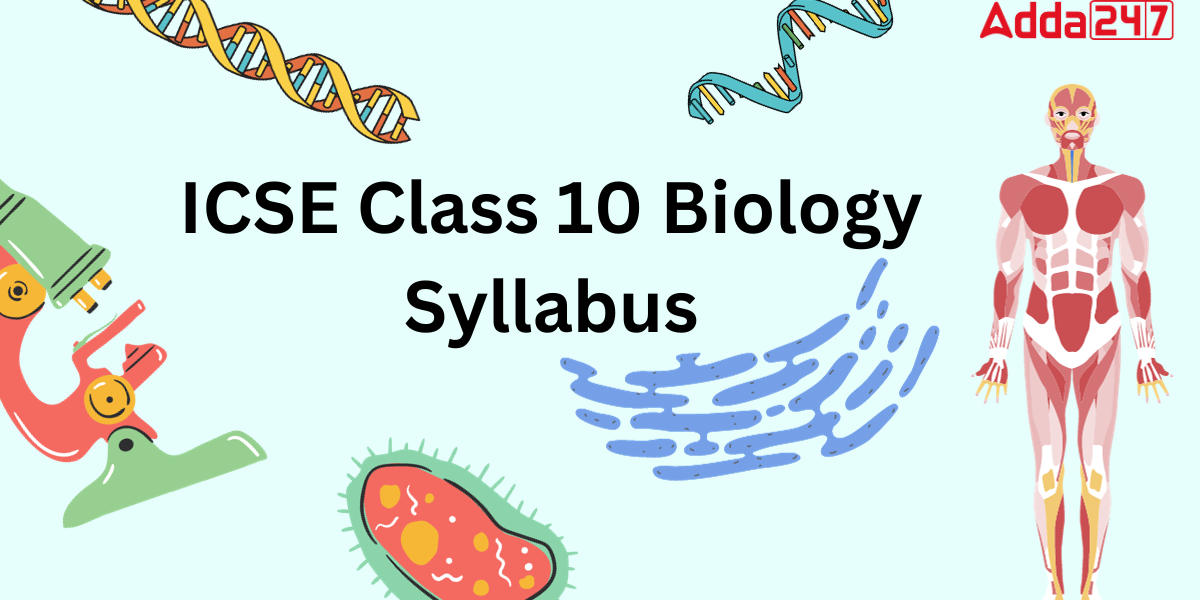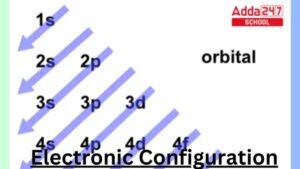ICSE Class 10 Biology Syllabus 2023-24 has been released by the Council for the Indian School Certificate Examinations on its official website at cisce.org.Candidates who are going to take the ICSE Class 10 board Exam this year must go through ICSE Class 10 Biology Syllabus 2023-24 to secure good marks in Biology Exam. ICSE Biology Syllabus Class 10 2023-24 is the key component that provides clear and very fine elaboration on units and, topics.
ICSE Class 10 Biology Syllabus 2023-24
The Council for the Indian School Certificate Examinations (CISCE) expects to hold the Class 10 exams 2024 in February – March 2024, thus now is the time to start preparing for the ICSE 2024 board exams. While studying and preparing for Class 10 Biology, students can refer to the most recent ICSE Class 10 Biology Syllabus 2023-24, which will help them familiar with the course structure’s topics/chapters. Students can find the ICSE Class 10 Biology Syllabus 2023-24 chapter-wise and topics explained on this page.
ICSE Syllabus Class 10 Biology Exam Pattern
Biology is a discipline of science that deals with the physical and chemical study of life, including the origin, structure, functions, evolution, distribution, identification, and classification of organisms. Candidates taking the ICSE Class 10 board Exams in 2024 should be familiar with the ICSE Class 10 Biology Syllabus 2023-24 as well as the Question Paper Design. Examine the key points of the ICSE Class 10 Biology Question Paper.
- There will be one paper of two hours duration of 80 marks and Internal Assessment of practical work
carrying 20 marks.
- The paper will be divided into two sections, Section I (40 marks) and Section II (40 marks).
- Section I (compulsory) will contain short answer questions on the entire syllabus.
- Section II will contain six questions. Candidates will be required to answer any four of these six questions
ICSE Class 10 Biology Syllabus 2023-24 Pdf Download
The ICSE Class 10 Biology Syllabus 2023-24 PDF is now available for download on the CISCE website. Candidates who plan to take the forthcoming Class 10 board exam can download the ICSE Class 10 Biology Syllabus 2023-24 PDF and begin preparing accordingly. We have provided a direct link to download the ICSE Class 10 Biology Syllabus 2024 PDF below for the student’s convenience.
ICSE Class 10 Biology Syllabus 2023-24 Download PDF
ICSE Class 10 Biology Syllabus 2023-24 Chapter-wise
The ICSE Class 10 Biology Syllabus 2023-24 is separated into six chapters, which include Plant Physiology, Human Anatomy and Physiology, Population, Human Evolution, and so on. For their final exams, students must study the entire syllabus as the ICSE (Class X) Examination paper will be based ONLY on the Class X portion of the syllabus. Candidates must thoroughly study and revise all of the topics in the ICSE Class 10 Biology Syllabus 2023-24 in order to achieve high marks in the Class 10 Biology exam. The following topics and subjects are included in the ICSE Class 10 Biology Syllabus 2023-24.
ICSE Class 10 Biology Chapter 1
| Chapter 1: Basic Biology |
| (i) Cell Cycle and Cell Division. Cell cycle – Interphase (G1, S, G2) and Mitotic phase.
Cell Division:
- Mitosis and its stages.
- A basic understanding of Meiosis as a reduction division (stages not required).
- A brief idea of homologous chromosomes and crossing over leading to variations.
- Significance and major differences between mitotic and meiotic division.
|
| (ii) Structure of chromosome. The basic structure of chromosomes with an elementary understanding of terms such as chromatin, chromatid, gene structure of DNA, and centromere. |
(iii) Genetics: Mendel’s laws of inheritance and sex-linked inheritance of diseases.
- The three laws of Mendel.
- Monohybrid cross–phenotype and genotype.
- Dihybrid cross – Only phenotype.
- The following terms to be covered: gene, allele, heterozygous, homozygous, dominant, recessive, mutation, variation, phenotype, genotype.
- Sex determination in human beings. Sex-linked inheritance of diseases to include only X-linked like hemophilia and colour blindness.
|
ICSE Class 10 Biology Chapter 2
| 2. Plant Physiology |
(i) Absorption by roots, imbibition, diffusion and osmosis; osmotic pressure, root pressure; turgidity and flaccidity; plasmolysis and deplasmolysis; the absorption of water and minerals; active and passive transport (in brief); The rise of water up to the xylem;Forces responsible for ascent of sap.
- Understanding of the processes related to absorption of water by the roots.
- Characteristics of roots, which make them suitable for absorbing water.
- Structure of a single full-grown root hair.
- A general idea of Cohesive, Adhesive forces and transpirational pull.
- Experiments to show the conduction of water through the xylem.
|
(ii) Transpiration – process and significance. Ganong’s photometer and its limitations. The factors affecting rate of transpiration.Experiments on transpiration. A brief idea of guttation and bleeding.
- Concept of transpiration and its importance to plants
- Experiments related to transpiration:
(a) Loss in weight of a potted plant or a leafy shoot in a test tube as a result of transpiration.
(b)Use of cobalt chloride paper to demonstrate unequal rate of transpiration in a dorsiventral leaf.
- Mechanism of stomatal transpiration on the basis of potassium ion exchange theory.
- Adaptations in plants to reduce transpiration.
- A brief idea of guttation and bleeding.
|
(iii)Photosynthesis: the process and its importance to life in general; experiments to show the necessity of light, carbon dioxide, chlorophyll, formation of starch and release of oxygen; carbon cycle. . The process and significance of Photosynthesis.
- The internal structure of chloroplast to be explained to give an idea of the site of light and dark reactions.
- Opening and closing of stomata based on potassium ion exchange theory.
- Overall balanced chemical equation to represent photosynthesis.
- Introduction of the terms “photochemical” for light phase and “biosynthetic” for dark phases.
- Light reaction – activation of chlorophyll followed by photolysis of water, release of O2, formation of ATP (photophosphorylation) and NADPH.
- Dark reaction – only combination of hydrogen released by NADP with CO2 to form glucose. (detailed equations are not required).
- Adaptations in plants for photosynthesis.
- Experiments with regard to the factors essential for photosynthesis; emphasis on destarching and the steps involved in starch test.
- A diagrammatic representation of “carbon cycle”.
|
(iv) Chemical coordination in Plants: A general study of plant growth regulators; Tropic movements in plants. A brief idea of the physiological effects of Auxins, Gibberellins, Cytokinins, Abscisic acid and Ethylene in regulating the growth of plants.
- A basic understanding of the tropic movements in plants with reference to – Phototropism, Geotropism,
Hydrotropism, Thigmotropism, and Chemotropism (supported with suitable examples).
|
ICSE Class 10 Biology Chapter 3
| Chapter 3: Human Anatomy and Physiology |
(i) Circulatory System: Blood and lymph, the structure and working of the heart, blood vessels, circulation of blood (only names of the main blood vessels entering and leaving the heart, liver and kidney will be required).
Lymphatic system.
- Composition of blood (structure and functions of RBC, WBC and platelets).
- Brief idea of tissue fluid and lymph.
- Increase in efficiency of mammalian red blood cells due to absence of certain organelles; reasons for the same.
- A brief idea of blood coagulation. Structure and working of the heart along with names of the main blood vessels entering and leaving the heart, the liver and the kidney.
- Concept of systole and diastole; concept of double circulation.
- Brief idea of pulse and blood pressure.
- Blood vessels: artery, vein and capillary to be explained with the help of diagrams to bring out the relationship between their structure and function.
- Brief idea of the lymphatic organs: spleen and tonsils.
- ABO blood group system, Rh factor.
- Significance of the hepatic portal system.
|
(ii) Excretory System: A brief introduction to the excretory organs; parts of the urinary system; structure and function of the kidneys; blood vessels associated with kidneys; structure and function of nephron
- A brief idea of different excretory organs in the human body.
- The external and internal structure of the kidney;
- Parts of the urinary system along with the blood vessels entering and leaving the kidney; functions of various parts of the urinary system (emphasis on the diagram with correct labeling). A general idea of the structure of a kidney tubule/ nephron
- A brief idea of ultra-filtration (emphasis on the diagram of Malpighian capsule); selective reabsorption and tubular secretion in relation to the composition of blood plasma and urine formed.
|
(iii)Nervous system: Structure of Neuron; central, autonomous and peripheral nervous system (in brief); brain and spinal cord; reflex action and how it differs from voluntary action. Sense organs – Eye: Structure, functions,
defects and corrective measures: Ear: Parts and functions of the ear.
- Parts of a neuron.
- Various parts of the external structure of the brain and its primary parts: Medulla Oblongata, Cerebrum, Cerebellum, Thalamus, Hypothalamus and Pons; their functions.
- Reference to the distribution of white and gray matter in Brain and Spinal cord.
- Voluntary and involuntary actions – meaning with examples.
- Diagrammatic explanation of the reflex arc, showing the pathway from receptor to effector.
- A brief idea of the peripheral and autonomic nervous system in regulating body activities.
- Differences between natural and acquired reflex.
- External and Internal structure and functions of the Eye and Ear and their various parts.
- A brief idea of stereoscopic vision, adaptation and accommodation of eye.
- Defects of the eye (myopia, hyperopia hypermetropia, presbyopia, astigmatism and cataract) and corrective measures (diagrams included for myopia and hyperopia only)
- The course of perception of sound in human ear.
- Role of the ear in maintaining balance of the body
|
(iv) Endocrine System: General study of the following glands: Adrenal, Pancreas, Thyroid and Pituitary. Endocrine and Exocrine glands.
- Differences between Endocrine and Exocrine glands.
- Exact location and shape of the endocrine glands in the human body.
- Hormones secreted by the following glands: Pancreas: insulin and glucagon; Thyroid: only thyroxin; Adrenal gland: Cortical hormones and adrenaline; Pituitary: growth hormone, tropic hormones, ADH and oxytocin.
- Effects of hypo secretion and hyper secretion of hormones.
- A brief idea of the Feedback mechanism with reference to TSH.
|
(v) The Reproductive System: Organs, fertilisation functions of placenta in the growth of the embryo Menstrual cycle.
- Functions of Male and Female reproductive organs and male accessory glands. An idea of secondary sexual
characters.
- Structure and functions of the various parts of the sperm and egg.
- Explanation of the terms: Fertilization, implantation, placenta, gestation and parturition.
- A brief idea of the role of placenta in nutrition, respiration and excretion of the embryo; its endocrinal function.
- Functions of Foetal membranes and amniotic fluid.
- Menstrual cycle outline of menstrual cycle.
- Role of Sex hormones: Testosterone, Oestrogen and Progesterone in reproduction.
- Identical and fraternal twins: meaning and differences only
|
ICSE Class 10 Biology Chapter 4
| Chepter 4: Population |
Population explosion in India; need for adopting control measures – population control.
- Main reasons for the sharp rise in human population in India and in the world.
- A brief explanation of the terms: demography, population density, birth rate, death rate and growth rate of population.
- Problems faced due to population explosion: unemployment, over exploitation of natural
resources, low per capita income, price rise, pollution, unequal distribution of wealth.
- Methods of population control: Surgical methods – Tubectomy and vasectomy.
|
ICSE Class 10 Biology Chapter 5
| Chepter 5: Human Evolution |
Basic introduction to Human evolution and Theories of evolution: Lamarck’s theory of
inheritance; Darwin’s theory of evolution by natural selection.
- A brief idea of human ancestors – Australopithecus, Homo habilis, Homo erectus, Neanderthals, Cro-Magnon and Homo sapiens sapiens (Modern Man) with reference to the following characteristics:
– Bipedalism
– Increasing Cranial capacity
– Reduction of size of canine teeth
– Forehead and brow ridges
– Development of chin
– Reduction in body hair
– Height and Posture
- Lamarck’s theory of inheritance of acquired characteristics – with reference to use of
organs (e.g.: neck and forelimbs of giraffe) and disuse of organs (e.g.: vestigial organs in humans like wisdom teeth, vermiform appendix, pinnae).
- Darwin’s theory of Natural selection: Survival of the fittest – e.g. adaptation of peppered moth.
|
ICSE Class 10 Biology Chapter 6
| Chapter 6: Pollution |
(i) Types and sources of pollution; major pollutants.
- Air: Vehicular, industrial, burning garbage, brick kilns.
- Water: Household detergents, sewage, industrial waste, oil spills.
- Thermal pollution.
- Soil: Industrial waste, urban commercial and domestic waste, chemical fertilizers.
- Biomedical waste – used and discarded needles, syringes, soiled dressings etc.
- Radiation: X-rays; radioactive fallout from nuclear plants.
- Noise: Motor Vehicles, Industrial establishments, Construction Sites, Loudspeakers etc.
|
(ii) Biodegradable and Non-biodegradable wastes Biodegradable wastes: meaning and example; paper, vegetable peels, etc. Non-biodegradable wastes: meaning and example; plastics, glass, Styrofoam etc.
Pesticides like DDT etc. |
(iii)Effects of pollution on climate, environment, human health and other organisms; control measures.
- Brief explanation of the greenhouse effect and Global warming, Acid rain, Ozone layer depletion.
- Measures to control pollution:
– Use of unleaded petrol / CNG in automobiles
– Switching of engines at traffic signal lights
– Social forestry
– Setting of sewage treatment plants
– Ban on polythene and plastics
– Organic farming
– Euro Bharat vehicular standard. (A brief idea of the above measures)
- A brief mention of “Swachh Bharat Abhiyan”- A national campaign for Clean India.
|
Sharing is caring!


 CLAT Admit Card 2025 Download Link Out a...
CLAT Admit Card 2025 Download Link Out a...
 Cu Electron Configuration, Copper Electr...
Cu Electron Configuration, Copper Electr...
 Electronic Configuration- Check Electron...
Electronic Configuration- Check Electron...






























